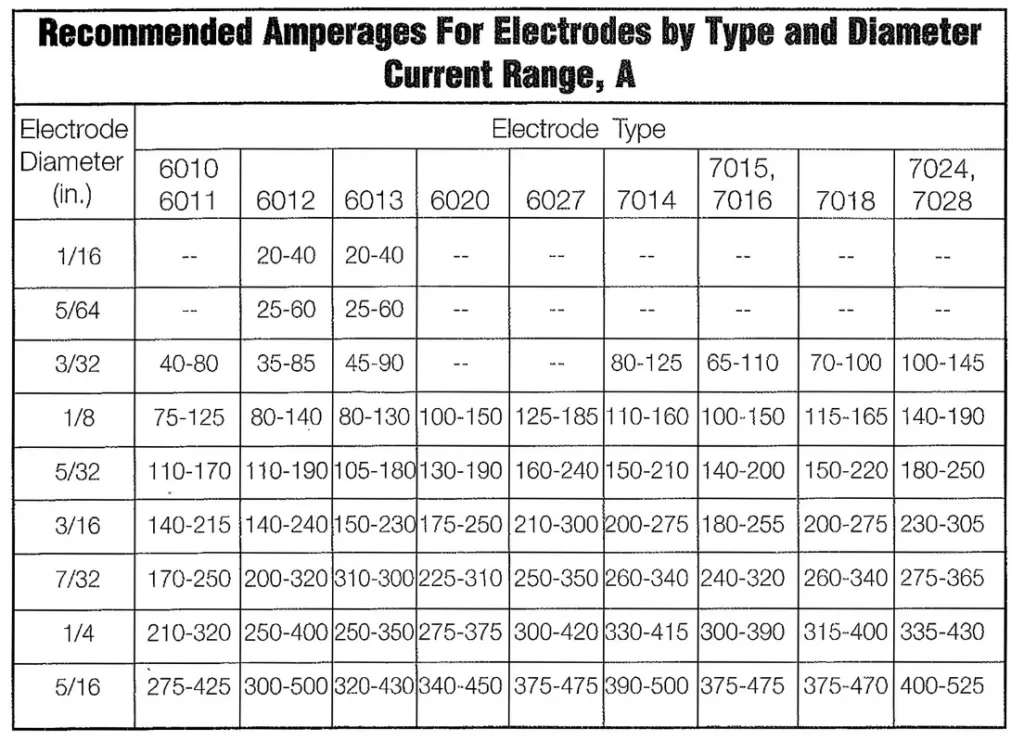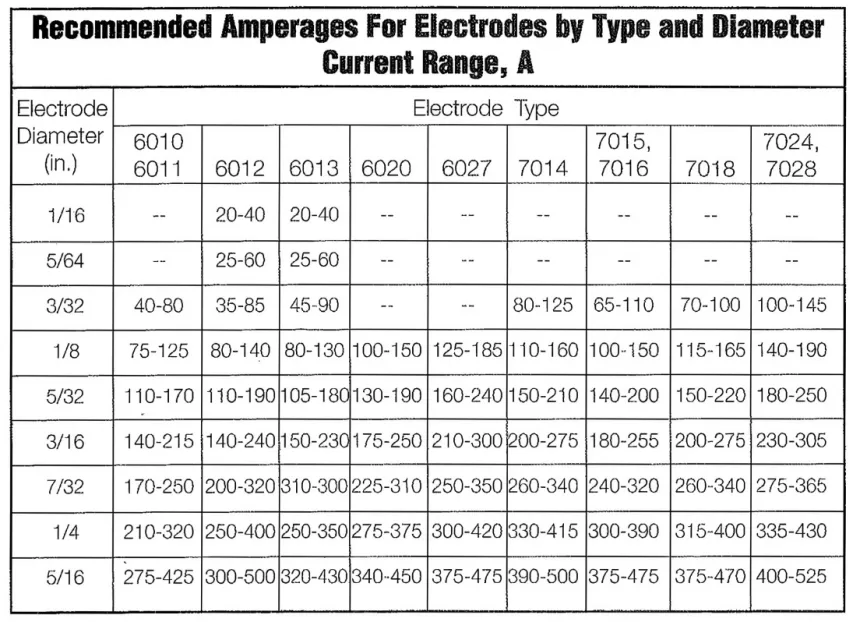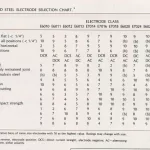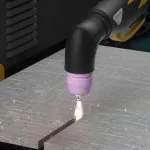There are many different sizes of welding rods and as a welder, it is a bit difficult to remember all of them. Especially since most of us have welding rods that we use on a daily basis. Every now and then we have to pick up a welding rod that we haven’t used in a long time. That’s why I decided to create this resource – whether you’re a beginner or an experienced welder, this resource will give you all the information you might need when picking up a welding rod.
Stick Welding Electrode Chart
Welding Town
The charts below of the different welding rods should give you a good idea of which rod to use when and on what settings. Keep in mind, however, that they are purely an estimate. Since welding parameters depend on so many variables, such as weld position, thickness and type of metal being welded, welding current, and level of experience, it is almost impossible to give a straight answer.
As a rule of thumb before continuing to weld, remember that if your electrode starts to glow when you are about to complete the electrode weld, your electrode is too hot. Turn the temperature down a bit and try again. If you are not an experienced welder, get some practice before you start your main project.

Welding Rod Sizes Sizes & Material Thickness Chart (Mild Steel)
| Size of the electrode | The thickness of the base metal |
| 1/16“ or 1.6 mm | Less than 3/16“ |
| 1/4“ or 6.4 mm | More than 3/8“ |
| 1/8“ or 3.2 mm | More than 1/8“ |
| 3/16“ or 4.8 mm | More than 3/8“ |
| 3/32“ or 2.4 mm | Less than 1/4″ |
| 5/32“ or 4.0 mm | More than 1/4″ |
| 5/64“ or 2.0 mm | Less than 3/8 |
E6010 and E6011 Size and Amperage Chart
Welding electrodes 6010 and 6011 are virtually the same type of electrode. Both electrodes have a vigorous arc, both are fast-setting all-positioning electrodes with a thin, thin slag and deep penetration. The only difference is that they are designed for different polarities; E6010 is a high cellulose sodium rod for use in DCEP, while the 6011 is a high cellulose potassium rod for use in AC, DCEP and DCEN.
Both rods are ideal for home use as they don’t require a lot of preparation – light rust, paint and galvanised surfaces are not a problem.
As they are instant manganese rods, the manganese beads look a little rougher, whilst they produce a fair amount of spatter compared to other manganese rods.
| E6010/E6011 | Size | Amperage range |
| 1/4“ or 6.4 mm | 210-315 | |
| 1/8“ or 3.2 mm | 75-125 | |
| 3/16“ or 4.8 mm | 140-210 | |
| 3/32“ or 2.4 mm | 40-85 | |
| 5/32“ or 4.0 mm | 110-165 | |
| 7/32“ or 5.6 mm | 160-250 |
E6012 Size and Amperage Chart
Welding electrode E6012 is a high titanium sodium electrode designed to fill gaps between joints because of its excellent bridging ability, but is often overlooked because of the high density of slag it produces. It can be used on both AC and DC power sources with a soft and stable arc.
The Model 6012 is an excellent tungsten rod for home and hobby use. Similar to 6013, it does not penetrate as well, but produces a nice even bead, making it suitable for welding sheet metal and artwork.
| E6012 | Size | Amperage range |
| 1/16“ or 1.6 mm | 20-40 | |
| 1/4“ or 6.4 mm | 250-400 | |
| 1/8“ or 3.2 mm | 80-140 | |
| 3/16“ or 4.8 mm | 140-240 | |
| 3/32“ or 2.4 mm | 35-85 | |
| 5/32“ or 4.0 mm | 110-190 | |
| 5/64“ or 2.0 mm | 25-60 | |
| 7/32“ or 5.6 mm | 200-320 |
E6013 Size and Amperage Chart
E6013 electrode is a high titanium potassium electrode designed for welding sheet metal. It can be used on AC, DC EP and DC power sources. With low penetration, dense slag, and a soft, stable arc, this electrode can be used in all positions, but requires a clean base metal to weld.
I think most welders would agree that 6013 is an excellent all-around electrode, even though it is designed for sheet metal.6013 is also highly utilized by novice welders because it is easy to create and maintain an arc with it.
| E6013 | Size | Amperage range |
| 1/16“ or 1.6 mm | 20-45 | |
| 1/4“ or 6.4 mm | 250-350 | |
| 1/8“ or 3.2 mm | 80-130 | |
| 3/16“ or 4.8 mm | 150-230 | |
| 3/32“ or 2.4 mm | 40-90 | |
| 5/32“ or 4.0 mm | 105-180 | |
| 5/64“ or 2.0 mm | 35-60 | |
| 7/32“ or 5.6 mm | 210-300 |
E7014 Size and Amperage Chart
E7014 is a powdered iron and titania rod that can be used in AC, DCEP and DCEN currents. The rod has medium penetration, a stable arc, can be used in all positions and produces smooth beads and thick, easy-to-remove dross. Although the rod is classified as an “all-position rod,” it is best suited for flat welds, as it is difficult to use the 7014 vertically.
E7014 is very similar to 6013, but due to the added iron powder it has a higher deposition rate. It also penetrates a little more than 6013. From a beginner’s point of view, it is debatable whether 7014 is an even easier rod to handle than 6013.
The 7014 electrode is used primarily on heavy plate and building structures of all types. For artistic welding enthusiasts, it is a great rod because of the clean-looking beads that can be laid up with it.
| E7014 | Size | Amperage range |
| 1/4“ or 6.4 mm | 330-415 | |
| 1/8“ or 3.2 mm | 110-165 | |
| 3/16“ or 4.8 mm | 200-275 | |
| 3/32“ or 2.4 mm | 80-125 | |
| 5/32“ or 4.0 mm | 150-210 | |
| 7/32“ or 5.6 mm | 225-340 |
E7018 Size and Amperage Chart
E7018 is a DCEP/AC rod, with low potassium hydrogen and iron powder composition. It produces thick fluid slag, uniform beads and has medium penetration. Because of its fluid slag, it can be used in all positions except vertical down.
What differentiates 7018 from other rod electrodes commonly found on the market is the fact that it requires special storage conditions. This is due to the hydrogen composition of its flux. The storage requirements limit the use of 7018 rods among domestic welders, so they are mostly used in construction and shipbuilding.
| E7018 | Size | Amperage range |
| 1/4“ or 6.4 mm | 320-400 | |
| 1/8“ or 3.2 mm | 110-165 | |
| 3/16“ or 4.8 mm | 200-275 | |
| 3/32“ or 2.4 mm | 65-100 | |
| 5/32“ or 4.0 mm | 150-220 | |
| 7/32“ or 5.6 mm | 260-340 |
E7024 Size and Amperage Chart
E7024 is an iron powder titanium welding rod that can operate with all three polarity settings for flat and horizontal downward welds. Due to its high iron powder composition, the rod requires higher amperage than rods of similar diameter, while having a higher deposition rate.
The rod is often used in mild steel, but can also be used in low alloy steels and high carbon steels. In a mill, because of its versatility and strength, this rod is often used to weld structural steels and large machinery components, such as truck frames or storage tanks.
| E7024 | Size | Amperage range |
| 1/4“ or 6.4 mm | 335-430 | |
| 1/8“ or 3.2 mm | 140-190 | |
| 3/16“ or 4.8 mm | 230-305 | |
| 3/32“ or 2.4 mm | 100-145 | |
| 5/32“ or 4.0 mm | 180-250 | |
| 7/32“ or 5.6 mm | 275-365 |
E308L Stainless Steel Welding Rod Chart
E308L is one of the main rods used for welding stainless steel (308 and 304). The rod can be used in AC and DCEP, offers low penetration but at the same time can be used for welding in all positions.
| E308L | Size | Amperage Range |
| 1/8“ or 3.2 mm | 75-115 | |
| 3/32“ or 2.4 mm | 40-80 | |
| 5/32“ or 4.0 mm | 105-160 |
Ni-CL Cast Iron Welding Rod Chart
If you are interested in learning more about welding cast iron with a stick welder, check out this post as well.
| Ni-CL | Size | Amperage Range |
| 1/8“ or 3.2 mm | 65-85 | |
| 3/16“ or 4.8 mm | 130-175 | |
| 3/32“ or 2.4 mm | 50-70 | |
| 5/32“ or 4 mm | 100-140 |
Flux Composition & Current Chart
The fourth digit on the welding rod (“xxxX”) represents the flux coating composition that the given welding rod has, in turn, this determines the type of current the rod can be used on. For example, 6010 is a high cellulose sodium rod that can only be run on DCEP/DC+
| NO. | FLUX COATING | CURRENT |
| 0 | HIGH CELLULOSE SODIUM | DC+ |
| 1 | HIGH CELLULOSE POTASSIUM | AC, DC+, DC- |
| 2 | HIGH TITANIA SODIUM | AC, DC- |
| 3 | HIGH TITANIA POTASSIUM | AC, DC+ |
| 4 | IRON POWDER, TITANIA | AC, DC+, DC- |
| 5 | LOW HYDROGEN SODIUM | DC+ |
| 6 | LOW HYDROGEN POTASSIUM | AC, DC + |
| 7 | HIGH IRON OXIDE, POTASSIUM POWDER | AC, DC+, DC- |
| 8 | LOW HYDROGEN POTASSIUM, IRON POWDER | AC, DC+, DC- |
Welding Rods by Flux Composition, Welding Position, Compatible Currents & Penetration Level
The following table helps to understand how flux composition affects the position in which a given welding rod can be used. For example 7018 and 7028. They are both High Iron Powder rods which limit the position they can be used and their ease of use in general. In the case of 7028, the third digit “xxXx” is 2 – which represents the position the rod can be used in. It also reflects the high amount of iron powder in the rod. If the iron powder composition goes above 50% the third digit is converted to XX28.
| WELDING ROD | FLUX COMPOSITION | WELDING POSITION | COMPATIBLE CURRENTS | PENETRATION | WELD STRENGTH |
| 6010 | High cellulose sodium | ALL | DCEP | DEEP | 60,000 PSI |
| 6011 | High cellulose potassium | ALL | DCEP,DCEN, AC | DEEP | 60,000 PSI |
| 6012 | High titania sodium | ALL | DCEN, AC | MEDIUM | 60,000 PSI |
| 6013 | High titania potassium | ALL | DCEP, DCEN, AC | SHALLOW | 60,000 PSI |
| 7018 | Iron powder low hydrogen | Difficult to run vertical down. | DCEP, AC | MEDIUM | 70,000 PSI |
| 7028 | Iron powder | HORIZONTAL OR FLAT | DCEP, AC | MEDIUM | 70,000 PSI |
Chart – How Much Welding Rod Do You Need?
The chart below is meant for fillet welds. The fillet size (L) is meant to represent the base and height of the triangle used in the formula I talk about in the post here. Also keep in mind that this is a rough estimate, different types of electrodes might have different requirements.
| FILLET SIZE (L) Inch (Mm) | WELD METAL REQUIREMENT lbs/ft (kg/m) | SMAW Pounds/Foot (Kilos/Meter) | GMAW Pounds/Foot (Kilos/Meter) |
| 1/8“ (3.2) | 0.027 (0.040) | 0.043 (0.064) | 0.028 (0.042) |
| 3/16“ (4.7) | 0.060 (0.089) | 0.097 (0.144) | 0.063 (0.094) |
| ¼“ (6.3) | 0.106 (0.158) | 0.171 (0.254) | 0.112 (0.167) |
| 5/16“ (7.9) | 0.166 (0.247) | 0.268 (0.399) | 0.175 (0.260) |
| 3/8“ (9.5) | 0.239 (0.356) | 0.385 (0.573) | 0.252 (0.375) |
| ½“ (12.7) | 0.425 (0.632) | 0.686 (1.020) | 0.447 (0.665) |
| 5/8“ (15.8) | 0.664 (0.988) | 1.071 (1.594) | 0.699 (1.040) |
| ¾“ (19.1) | 0.956 (1.423) | 1.542 (2.295) | 1.010 (1.503) |
| 1“ (25.4) | 1.698 (2.527) | 2.739 (4.076) | 1.787 (2.659) |











